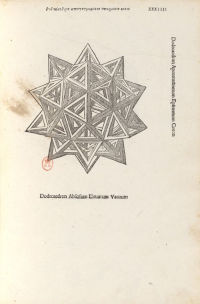Rule of Mathematics Click on the thumbnails to explore the trail
Read more about this trail (expand)
Leonardo believed that all things in nature were governed by mathematics. Mathematics was of supreme importance and expressed incontrovertible, universal truth. Knowledge of mathematics was a prerequisite for understanding the nature of all things. “Let no-one who is not a mathematician read my principles”, Leonardo said. Geometry and its actual or potential relationship to natural forms provided a suitably visual means for the exploration of mathematical “truths”.
Engraving of a dodecahedron after Leonardo 1509
Luca Pacioli’s treatise on proportions, De Divina Proportione, was originally produced in two manuscripts for Ludovico Sforza and Galeazzo Sanseverino in 1498. The printed version that appeared in 1509 contained engravings of the platonic solids based on drawings by Leonardo. For the first time, Leonardo’s work was published.
The platonic solids are three-dimensional shapes made up of polygonal faces, called polyhedra (cubes, prisms and pyramids are all polyhedra). There are five key solids - the tetrahedron (four sides), the cube (six sides), the octahedron (eight sides), the dodechahedron (twelve sides) and the icosahedron (twenty sides). By truncating these forms or adding “stellations”, new forms known as derivatives can be created, in a process of transformation that fascinated Leonardo.
Leonardo drew the platonic solids and some of their derivatives not only in solid but also in skeletal form. This technique was highly innovative and beautifully effective as a means of conveying the three-dimensionality of the polyhedra, which are notoriously difficult to draw.
Only the more complex polyhedra shown in the engravings of the printed version of Pacioli’s treatise, one of which is shown here, are based on Leonardo’s drawings.
In Leonardo's words
The other proof which Plato gave to those of Delos is not geometry, because you proceed by the instrument of compasses and ruler, and experience shows it to us. But this is an occupation of the mind and as a consequence, geometry
Leonardo drew a series of geometrical bodies for the manuscript versions of Luca Pacioli’s treatise on proportions.
Two of the original manuscripts have survived. The copy in the Biblioteca Ambrosiana, Milan, is dated 1498 and is of superior quality. It is dedicated to Galeazzo Sanseverino, commander of Ludovico Sforza’s army. The other, which is now in the Bibliothèque Publique et Universitaire, Geneva, was dedicated to Ludovico Sforza himself. It appears to be a compilation of notes and illustrations of lesser quality, probably compiled after the departure of Leonardo from Milan.
Luca’s treatise was published in Venice in 1509. Each of the regular solids together with some of their derivatives are illustrated in solid and skeletal form. The engravings of the more complex forms are based on Leonardo’s drawings.
The body illustrated in this engraving is a dodecahedron (twelve-sided). It has been truncated to produce triangular faces, and then stellated with equilateral pyramids added on each of its faces. The engraving shows the skeletal form drawn in perspective.
It is possible that Leonardo drew such complex geometric bodies with the aid of a drawing frame or “perspective window” as illustrated in the Codex Atlanticus for the depiction of an armillary sphere.
- Medium Engraving
- Size 29 x 45 cm
- Location Bibliothèque Nationale de France











